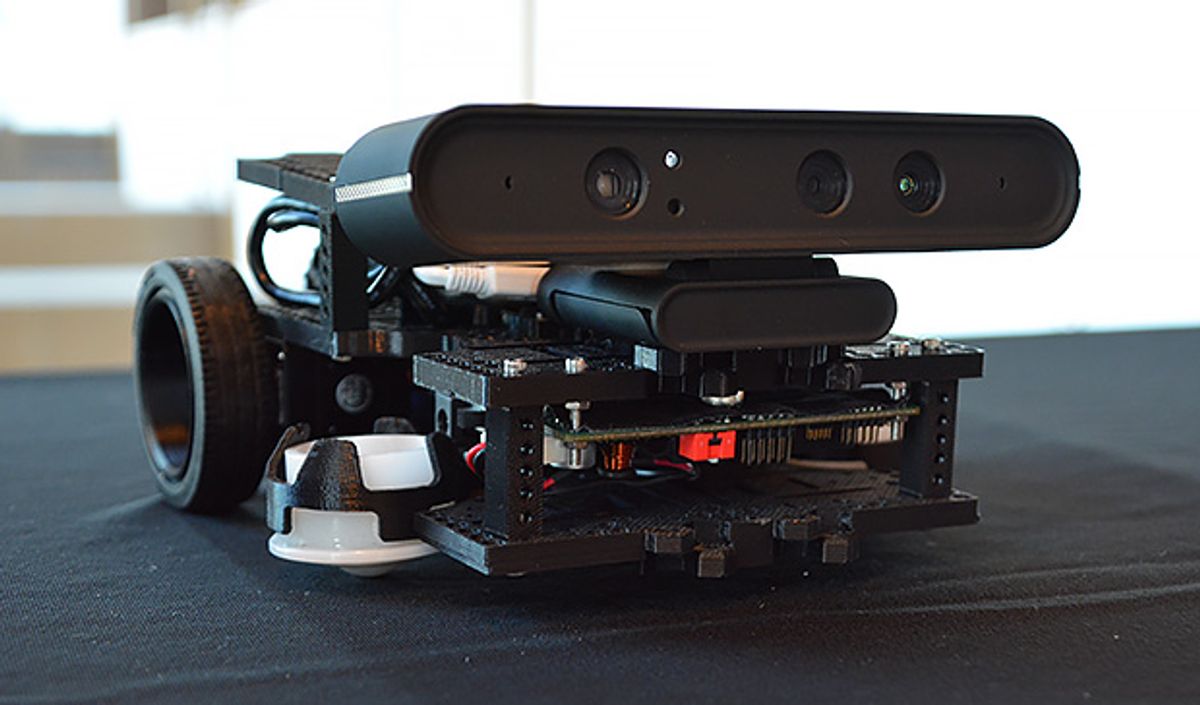Thousands of TurtleBots are out in the world right now, providing a (mostly) straightforward and (mostly) affordable way to get started with ROS. They’re (mostly) portable and (mostly) extendable, allowing you (with a limited amount of inconvenience) to modify the robot to keep up with your needs. TurtleBot 2 is a great platform (I certainly love mine), but its size and cost usually restrict it to people who already have some ROS experience, and know that a TurtleBot is something worth investing in. For people who want to get started with ROS but aren’t prepared to make as much of an investment, there just aren’t a lot of options with the same kind of community and support that you get with TurtleBot.
At ROSCon this past weekend, the Open Source Robotics Foundation (OSRF) and South Korean robot maker ROBOTIS are tackling these problems by announcing a shiny new version of TurtleBot: TurtleBot 3. TB3 is small enough to fit into a backpack, and with a single-board computer instead of a netbook and just two Dynamixel motors driving a pair of wheels, it’s both simpler than previous TurtleBots and significantly cheaper. With tons of easy options for expandability (including sensors, computers, drive systems, and more) and the kind of software support that TurtleBots are known for, TB3 seems like the best intro to doing cool stuff with ROS yet.
TurtleBot 3’s hardware is based around layered, 3D-printed plates that fit together like puzzle pieces. Or really, it’s just one plate that fits together with itself, and to make the robot bigger, you just get more plates and screw them together. The base version will include two rubber wheels driven by Dynamixel X series motors plus two casters, but if you want to upgrade to an awesome pair of tracks to turn your TB3 into a little all-terrain tank, it’s as easy as printing out two more wheel hubs, swapping some plates around, and adding a pair of servos and the tracks.

Sensors and computers work the same way. Out of the box, TB3 will be able to run on anything from a Raspberry Pi to an Intel Joule. Of course, what hardware you want depends on what kind of perception you’re trying to do, and TB3 is set up for a variety of USB cameras, RGB-D sensors, lidars, and of course all of the low-cost IR and ultrasonic sensors as well. With a Joule and a RGB-D camera or lidar, TB3 is powerful enough to do SLAM and navigation.
But wait, there’s more: Want to do manipulation of small things very close to the floor? No problem, stick an arm on it. With a little creativity, TB3 can turn into just about anything you want:
TB3 also uses a custom controller board developed by ROBOTIS. It’s completely open source, meaning that you can really get into the guts of the hardware and interfaces later, if that’s your thing:

According to ROBOTIS, the TB3 will start at around $500 when it becomes available next year, although they’re still trying to decide on the final specs and pricing model, and fancier versions (say, with an IntelJoule board and RealSense camera) could run you up to $1000. The price would be for a full kit— if you’re comfortable buying the electronics and sensors (or you already have some), and you 3D print the frame parts yourself, it’ll be even cheaper. And since it’s all modular, you can always just start with the base version (probably Raspberry Pi with a camera) and upgrade as you start to run into hardware constraints on what you’re trying to do.
ROBOTIS hopes that TB3’s low price and flexiblity will help it find a home in undergraduate robotics programs, and perhaps even in high schools, which are currently dominated by LEGO Mindstorms and Vex Robotics. We don’t mean to suggest that there’s anything wrong with those systems, but there’s no reason why ROS can’t be an option for early robotics education as well.
All the TurtleBot 3s we saw at ROSCon were prototypes, so nothing’s quite ready to go just yet, but we’ll definitely be updating you as soon as we have more info.
[ ROSCon 2016 ]
Evan Ackerman is a senior editor at IEEE Spectrum. Since 2007, he has written over 6,000 articles on robotics and technology. He has a degree in Martian geology and is excellent at playing bagpipes.



